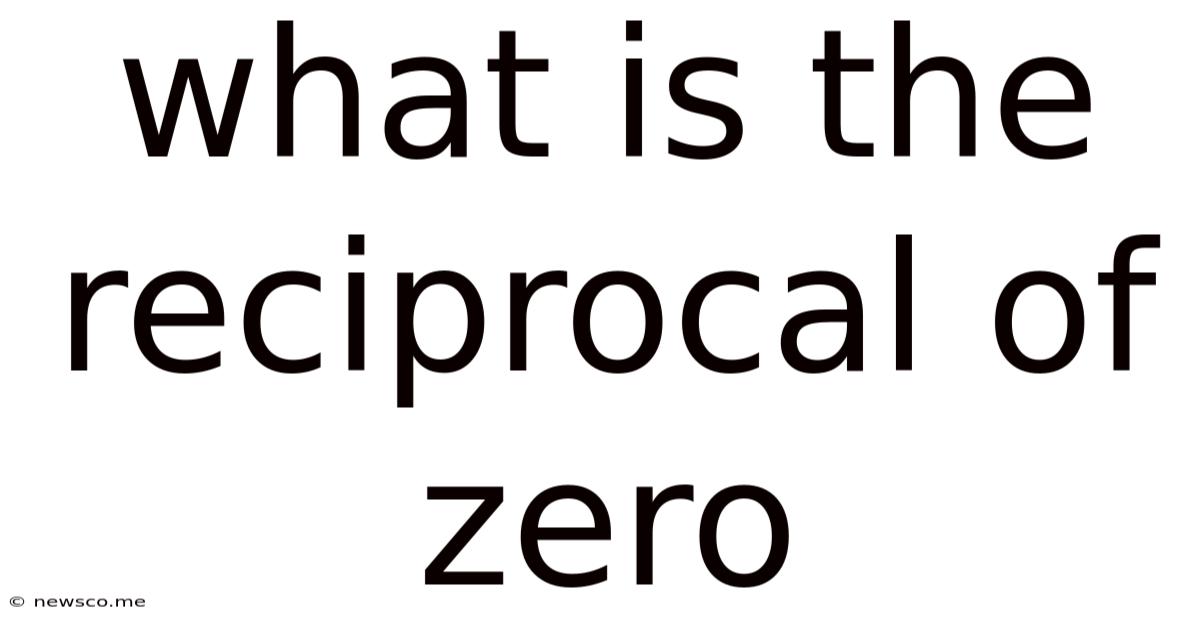What Is The Reciprocal Of Zero
News Co
Apr 18, 2025 · 4 min read

Table of Contents
What is the Reciprocal of Zero? Exploring the Concept of Infinity and Undefined Values
The question, "What is the reciprocal of zero?" appears deceptively simple, yet it delves into the fundamental nature of mathematics, specifically the intricacies of division by zero and the concept of infinity. Understanding the answer requires exploring the core principles of reciprocals, limits, and the extended real number system. This article will provide a comprehensive exploration of this intriguing mathematical concept.
Understanding Reciprocals
Before tackling the core question, let's establish a clear understanding of what a reciprocal is. In mathematics, the reciprocal of a number is simply 1 divided by that number. For instance:
- The reciprocal of 2 is 1/2 (or 0.5).
- The reciprocal of 5 is 1/5 (or 0.2).
- The reciprocal of -3 is 1/-3 (or -0.333...).
The reciprocal of a number, when multiplied by the original number, always equals 1. This property is crucial to many mathematical operations and concepts.
The Problem with Dividing by Zero
The core of the question lies in the impossibility of dividing by zero. Why is this? Let's examine it from a few perspectives:
1. The Definition of Division
Division is fundamentally the inverse operation of multiplication. When we say 6 ÷ 2 = 3, we're essentially asking, "What number, when multiplied by 2, equals 6?" The answer, of course, is 3.
Now, let's try to apply this to division by zero. If we had 6 ÷ 0 = x, we'd be asking, "What number, when multiplied by 0, equals 6?" There is no such number. Any number multiplied by 0 will always result in 0, never 6. This illustrates the inherent impossibility of the operation.
2. The Limit Approach
We can approach the concept of dividing by zero using the concept of limits in calculus. Consider the function f(x) = 1/x. As x approaches 0 from the positive side (x → 0+), the function's value approaches positive infinity (f(x) → ∞). Conversely, as x approaches 0 from the negative side (x → 0-), the function's value approaches negative infinity (f(x) → -∞).
This demonstrates that the limit of 1/x as x approaches 0 does not exist. The function does not approach a single value; instead, it diverges to both positive and negative infinity, depending on the direction of approach.
3. The Concept of Infinity
Infinity (∞) is not a number in the traditional sense; it's a concept representing something without bound or limit. While we can use infinity in certain mathematical contexts, like describing limits, we cannot perform standard arithmetic operations with it in the same way we do with real numbers. Saying that the reciprocal of zero is infinity overlooks the crucial distinction between a limit approaching infinity and a defined value of infinity.
The Reciprocal of Zero: Undefined
Given the impossibility of dividing by zero and the diverging behavior of the limit, we conclude that the reciprocal of zero is undefined. It is not a number; it's not infinity; it simply doesn't exist within the framework of standard mathematical operations.
Implications and Applications
The concept of undefined values, particularly concerning the reciprocal of zero, has significant implications across various fields of mathematics and its applications:
1. Calculus and Analysis:
Understanding limits and undefined values is fundamental to calculus and mathematical analysis. Many theorems and proofs rely on the careful handling of these concepts to avoid inconsistencies and paradoxical results.
2. Computer Science:
In programming, division by zero usually results in an error or exception. Programmers must implement error handling mechanisms to gracefully manage such situations and prevent program crashes.
3. Physics and Engineering:
Physical models often involve mathematical equations. Understanding when a division by zero might occur is crucial for ensuring the accuracy and reliability of simulations and predictions.
4. Financial Modeling:
Financial models can also incorporate mathematical formulas, and division by zero errors can lead to inaccurate financial projections and analyses.
The Extended Real Number System
To deal with concepts like infinity and the limits of functions, mathematicians often introduce the extended real number system. This system includes the symbols +∞ and -∞, representing positive and negative infinity, respectively. However, even within this extended system, the reciprocal of zero remains undefined. While the limit of 1/x as x approaches 0 might approach ±∞, zero itself doesn't have a defined reciprocal within this expanded framework. The extended real number system provides a more formal way to discuss limits involving infinity, but it doesn't change the fundamental fact that division by zero is undefined.
Conclusion: A Fundamental Limitation
The question of the reciprocal of zero highlights a fundamental limitation within the standard number systems and arithmetic operations. While concepts like infinity and limits offer tools for exploring the behavior of functions as they approach zero, they do not provide a defined reciprocal for zero itself. The reciprocal of zero remains undefined, a cornerstone concept in mathematics that underscores the importance of carefully defining and handling mathematical operations to avoid inconsistencies and paradoxes. Understanding this concept is essential for anyone delving deeper into mathematical and scientific fields. This understanding avoids misinterpretations and ensures the accuracy of calculations and models across numerous disciplines.
Latest Posts
Related Post
Thank you for visiting our website which covers about What Is The Reciprocal Of Zero . We hope the information provided has been useful to you. Feel free to contact us if you have any questions or need further assistance. See you next time and don't miss to bookmark.